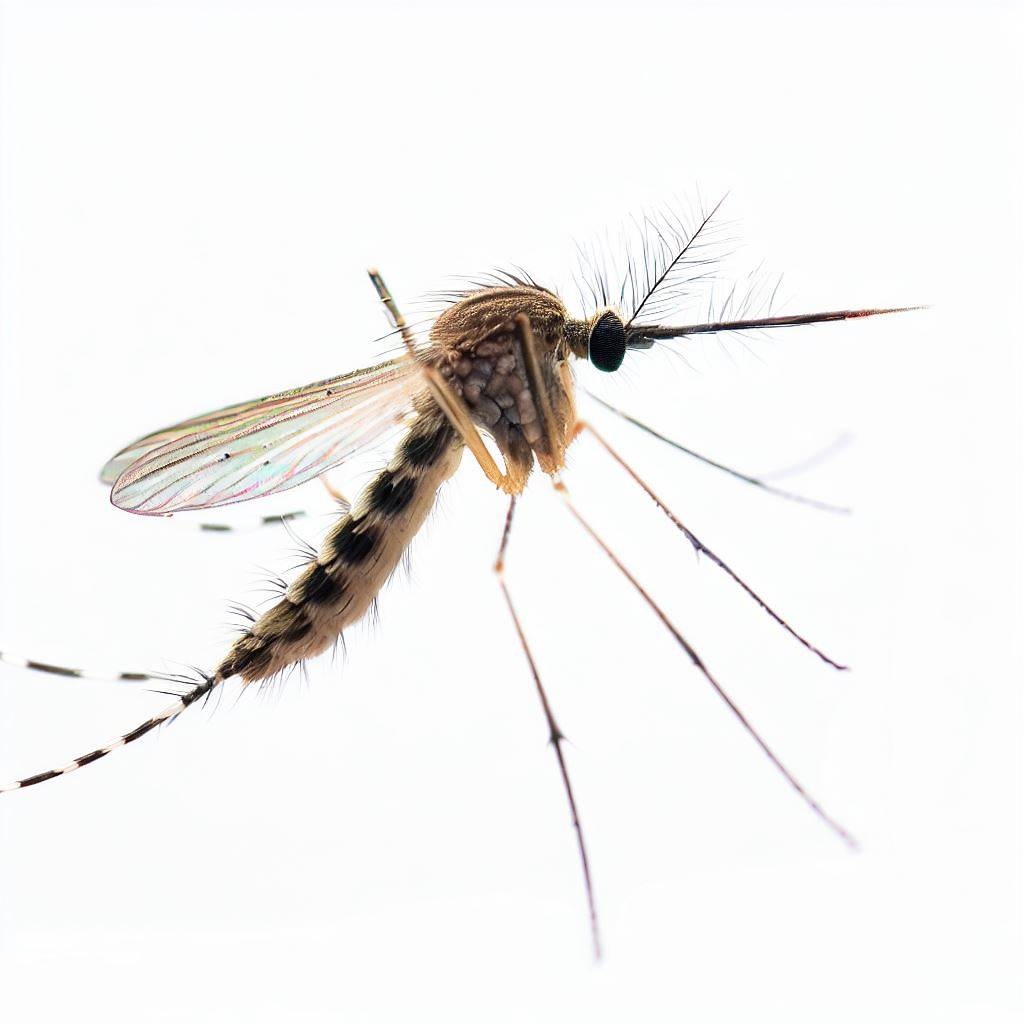Everything About Mosquitos

| Characteristics of Mosquitoes | |
|---|---|
| Feature | Description |
| Size | Typically range from 3 to 6 mm in length. |
| Color | Vary in color. Some common species are gray, but they can be brown, black, or even have white markings. |
| Wing Pattern | Transparent wings with unique vein patterns that can be used to differentiate species. |
| Diet | Females primarily feed on blood, while males typically consume nectar from plants. |
| Habitat | Found near stagnant water, as it's their breeding ground. Common in warm, humid areas. |
Dissecting Mosquitos Anatomy
Mosquitoes are winged insects known for their biting habits. Female mosquitoes feed on blood, which they need for the development of their eggs, while males typically feed on nectar. They belong to the family Culicidae. The anatomy of a mosquito has evolved to support its feeding and reproductive habits. Here’s a breakdown of a mosquito’s anatomy:
Head
Thorax
Abdomen
Internal Systems
Sensory Systems
Head
- Antennae: Mosquitoes have a pair of long, segmented antennae that are covered in fine hairs (setae). In males, these antennae are bushier and are used to detect the wing-beat frequency of females for mating.
- Proboscis: This is the elongated, needle-like mouthpart mosquitoes use to feed. In females, it’s adapted to pierce the skin and access blood vessels, while males have a less sharp proboscis suited for feeding on nectar.
- Maxillary Palps: These are sensory structures, often quite long, especially in males. They assist with detecting carbon dioxide and other chemicals.
- Compound Eyes: Mosquitoes have large compound eyes that provide a wide field of vision.
Thorax
- Wings: Each mosquito has a pair of transparent wings. The wings beat at a rapid frequency, creating their characteristic high-pitched buzz.
- Halteres: These are small knobbed structures derived from the hind wings. They function as gyroscopes, helping mosquitoes maintain stability in flight.
- Legs: Mosquitoes have three pairs of long and slender legs. These legs are often covered in scales and, when resting, are typically held high and away from the surface, giving them a distinctive stance.
Abdomen
- Segments: The abdomen is segmented and is the location for many of the mosquito’s vital internal organs. It is also where female mosquitoes store blood after feeding.
- Spiracles: These are openings along the abdomen that connect to the mosquito’s respiratory system, allowing it to breathe.
- Ovipositor: In females, this structure is used for laying eggs. It’s a specialized organ that can deposit eggs on or near water sources.
Internal Systems
- Digestive System: Once a female mosquito feeds on blood, the blood is stored in the midgut. Enzymes break down the blood, and the nutrients are used for egg development.
- Reproductive System: Only female mosquitoes bite because they need the proteins from the blood for the maturation of their eggs. After mating with males, females store the sperm in a special storage organ and use it to fertilize their eggs after each blood meal.
- Respiratory System: Mosquitoes don’t have lungs. They breathe through a system of tubes called tracheae, which connect to the external environment through spiracles.
- Circulatory System: Like other insects, mosquitoes have an open circulatory system. Their “blood” (called hemolymph) bathes the body’s organs directly.
Sensory Systems
- Chemical Sensors: Mosquitoes have specialized sensors for detecting carbon dioxide (CO2) and lactic acid, among other chemicals. This is how they can find hosts, even in the dark.
- Heat Sensors: Some species can detect the heat emitted by warm-blooded animals, helping them locate blood vessels close to the skin.
How Do I Get Rid Of MOSQUITOES?
Addressing mosquito problems involves reducing breeding grounds and employing targeted interventions.
With Mosquito Control & Treatment strategies, such as larvicides and adulticides, you can minimize their population.
Ensuring proper water drainage and using mosquito nets or repellents can be effective preventive measures.
For pervasive mosquito issues, turning to professionals specializing in Mosquito Control & Treatment ensures comprehensive protection.
What are the most common types of MOSQUITOES
in Canada?
Canada has a wide variety of mosquito species, many of which are commonly encountered during the warmer months. Here are six of the most common types of mosquitoes you might encounter in Canada:
- Common House Mosquito (Culex pipiens)
- Northern House Mosquito (Culex restuans)
- Eastern Treehole Mosquito (Aedes triseriatus)
- Snow Pool Mosquito (Aedes communis)
- Floodwater Mosquito (Aedes vexans)
- Malaria Mosquito (Anopheles quadrimaculatus)

Common House Mosquito

Northern House Mosquito

Eastern Treehole Mosquito

Snow Pool Mosquito

Floodwater Mosquito

Malaria Mosquito
Call us for a Free Mosquito Inspection
What are the characteristics of Common House Mosquito?

| Characteristics of Common House Mosquito (Culex pipiens) | |
|---|---|
| Feature | Description |
| Size | Approximately 4 to 7 mm in length. |
| Color | Pale brown with white stripes across the abdomen. |
| Feeding Habits | Primarily nocturnal feeders, drawn to humans and animals by carbon dioxide and body heat. |
| Breeding | Lay their eggs in stagnant water, including ponds, marshes, and containers with standing water. |
| Diseases | Can transmit various diseases including West Nile virus and St. Louis encephalitis. |
What are the characteristics of Northern House Mosquito?

| Characteristics of Northern House Mosquito (Culex pipiens pipiens) | |
|---|---|
| Feature | Description |
| Size | Approximately 4 to 8 mm in length. |
| Color | Light brown to gray with white patterns on its abdomen. |
| Feeding Habits | Typically feeds at dusk and dawn. Attracted to carbon dioxide, warmth, and certain odors. |
| Breeding | Favors stagnant water for laying eggs. Often found in clogged drains, rain barrels, and other water-holding containers. |
| Diseases | Can transmit various diseases including West Nile virus and St. Louis encephalitis. |
What are the characteristics of Eastern Treehole Mosquito?

| Characteristics of Eastern Treehole Mosquito (Aedes triseriatus) | |
|---|---|
| Feature | Description |
| Size | Approximately 4 to 7 mm in length. |
| Color | Black with white patterns and silvery scales on its body. |
| Feeding Habits | Prefers to feed on mammals, especially humans, during the day. |
| Breeding | Lays eggs in tree holes and man-made containers that collect water, such as discarded tires. |
| Diseases | Known vector for the La Crosse encephalitis virus. |
What are the characteristics of Snow Pool Mosquito?

| Characteristics of Snow Pool Mosquito (Aedes sp.) | |
|---|---|
| Feature | Description |
| Size | Typically around 4 to 8 mm in length. |
| Color | Dark brown or black with white or silvery stripe patterns. |
| Feeding Habits | Primarily active during the evening and feed on mammals, including humans. |
| Breeding | Lays eggs in temporary pools created by melting snow or spring rains. |
| Diseases | Generally not considered a significant disease vector, but their bites can be itchy and irritating. |
What are the characteristics of Floodwater Mosquito?

| Characteristics of Floodwater Mosquito (Aedes vexans) | |
|---|---|
| Feature | Description |
| Size | Typically ranging from 5 to 7 mm in length. |
| Color | Dark brown or black, often with pale stripes or bands. |
| Feeding Habits | Most active during dusk and dawn, but can bite during the day in shaded areas. They feed on both humans and animals. |
| Breeding | Lay their eggs on damp soil that will be flooded by rainwater, ensuring the larvae have a suitable habitat when they hatch. |
| Diseases | Can transmit several diseases, but they are primarily a nuisance due to their aggressive biting behavior. |
What are the characteristics of Malaria Mosquito?

| Characteristics of Malaria Mosquito (Anopheles species) | |
|---|---|
| Feature | Description |
| Size | Typically ranging from 4 to 12 mm in length. |
| Color | Pale brown with distinctive dark spots on the wings. |
| Feeding Habits | Most active during dusk and dawn. Only female mosquitoes bite and feed on blood to obtain nutrients for egg production. |
| Breeding | They lay eggs singly on the water surface, often in clean, unpolluted water including fresh or salt water marshes, mangroves, rice fields, grassy ditches, and the edges of streams and rivers. |
| Diseases | Primarily responsible for transmitting Plasmodium parasites, which cause malaria in humans. |
Call us for a Free Mosquito Inspection
Top Tips to Prevent Mosquito Infestations: Essential Guide
- Eliminate Standing Water: Mosquitoes breed in stagnant water. Regularly check and empty water from flower pots, bird baths, toys, and any other containers in your yard.
- Maintain Your Yard: Keep your grass mowed and shrubs trimmed. This reduces the resting places for adult mosquitoes.
- Use Mosquito Nets and Screens: Ensure that windows and door screens are free from holes and fit tightly. Consider using mosquito nets over beds in infested areas.
- Natural Repellents: Plant mosquito-repelling plants such as citronella, lavender, and marigold around your yard and outdoor seating areas.
- Use Repellents and Wear Protective Clothing: When outside during peak mosquito times (typically dawn and dusk), apply an EPA-approved insect repellent and wear long sleeves and pants to minimize exposure.
Frequently Asked Questions about Mosquito:
Mosquitoes are drawn to the carbon dioxide, body heat, and certain chemicals produced in sweat. Specific species of mosquitoes might be more attracted to certain blood types and the lactic acid, uric acid, and ammonia found in sweat.
The best approach is to eliminate their breeding sites. Mosquitoes need stagnant water to breed, so regularly check and empty any water-holding containers in your yard, such as flower pots, bird baths, and toys. Mosquito repellent plants and mosquito dunks can also help reduce their numbers.
No, not all mosquitoes carry diseases. However, certain species are known vectors for diseases like malaria, dengue fever, Zika virus, and West Nile virus, among others. It’s essential to protect yourself from mosquito bites to reduce the risk of infection.
